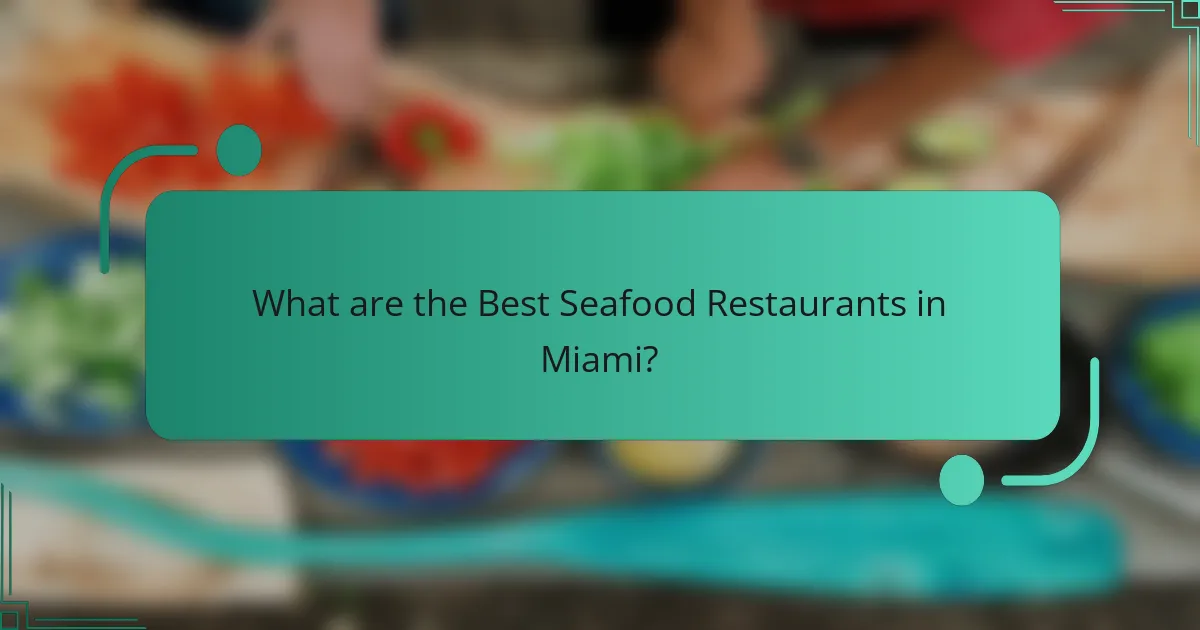The article focuses on the best seafood restaurants in Miami, highlighting renowned establishments such as Joe’s Stone Crab, The River Oyster Bar, and La Mar by Gastón Acurio. Key menu highlights include fresh stone crabs, ceviche, and grilled octopus, showcasing Miami’s diverse culinary influences. Customer reviews provide insights into the quality of food, service, and atmosphere, emphasizing the importance of freshness, preparation, and overall dining experience. The article serves as a comprehensive guide for potential diners seeking exceptional seafood options in Miami.

What are the Best Seafood Restaurants in Miami?
The best seafood restaurants in Miami include Joe’s Stone Crab, The River Oyster Bar, and La Mar by Gastón Acurio. Joe’s Stone Crab is renowned for its stone crab claws and has been a Miami staple since 1913. The River Oyster Bar offers a diverse selection of fresh oysters and seafood dishes in a casual atmosphere. La Mar by Gastón Acurio is celebrated for its Peruvian cuisine and ceviche, providing a unique dining experience. Each restaurant consistently receives high customer reviews for quality and service.
How do we define the ‘best’ seafood restaurants?
The ‘best’ seafood restaurants are defined by several key factors. Quality of ingredients is paramount. Freshness of seafood directly impacts flavor and taste. A diverse and innovative menu attracts a wider audience. Customer service plays a crucial role in dining experience. Ambiance contributes to overall enjoyment and comfort. Positive customer reviews and ratings reflect satisfaction and reliability. Consistent performance over time builds a strong reputation. Recognition from culinary awards can also signify excellence in the industry.
What criteria are used to evaluate seafood restaurants?
Criteria used to evaluate seafood restaurants include freshness of ingredients, quality of preparation, and menu variety. Freshness is crucial as it directly impacts flavor and safety. Quality of preparation refers to cooking techniques and presentation. Menu variety assesses the range of seafood options available. Customer service also plays a significant role in evaluation. Ambiance influences the dining experience, affecting overall satisfaction. Reviews from patrons provide insight into the restaurant’s reputation. These criteria collectively help determine the overall quality of seafood restaurants.
Why is Miami a prime location for seafood dining?
Miami is a prime location for seafood dining due to its coastal geography. The city is situated along the Atlantic Ocean, providing access to fresh seafood. Local fisheries and markets supply a variety of fish and shellfish daily. Miami’s diverse culinary scene incorporates influences from Latin America and the Caribbean. This fusion enhances seafood dishes with unique flavors and preparation styles. The warm climate supports year-round dining experiences, often outdoors. Additionally, Miami hosts numerous seafood festivals celebrating local cuisine. These factors contribute to Miami’s reputation as a top destination for seafood lovers.
What are the key features of top seafood restaurants in Miami?
Top seafood restaurants in Miami feature fresh, high-quality ingredients. They often source seafood locally from Florida waters. Many offer a diverse menu that includes both traditional and innovative dishes. A vibrant and inviting ambiance is also characteristic of these establishments. Many have waterfront views or outdoor seating to enhance the dining experience. Exceptional customer service is a key aspect, with staff knowledgeable about the menu. Additionally, top seafood restaurants often provide a selection of wine and cocktails that pair well with seafood. Regular customer reviews highlight the freshness of the food and the overall dining experience.
How does ambiance influence the dining experience?
Ambiance significantly influences the dining experience by affecting mood and perception. A well-designed ambiance can enhance enjoyment and satisfaction. Factors like lighting, music, and decor play crucial roles. For instance, dim lighting can create intimacy, while upbeat music can energize the atmosphere. Research shows that pleasant surroundings can increase meal enjoyment by up to 30%. Furthermore, the ambiance can shape customer expectations regarding food quality. A vibrant, stylish setting often leads diners to anticipate higher culinary standards. Overall, ambiance is a key element that shapes the overall dining experience.
What types of seafood are commonly featured on menus?
Common types of seafood featured on menus include fish, shellfish, and crustaceans. Fish varieties often include salmon, tuna, and cod. Shellfish typically consists of shrimp, scallops, and oysters. Crustaceans are commonly represented by lobsters and crabs. Many seafood restaurants highlight seasonal catches to offer freshness. Popular preparations include grilling, frying, and steaming. Menus may also showcase specialty dishes like seafood pasta or paella. The diversity of seafood options caters to various culinary preferences.
What role do customer reviews play in selecting seafood restaurants?
Customer reviews significantly influence the selection of seafood restaurants. They provide insights into food quality, service, and overall dining experience. Many diners rely on reviews to gauge freshness and taste of seafood. Positive reviews can enhance a restaurant’s reputation and attract more customers. Conversely, negative reviews can deter potential patrons. Research indicates that 84% of people trust online reviews as much as personal recommendations. Additionally, a high rating on platforms like Yelp or Google can lead to increased foot traffic. Overall, customer reviews serve as a crucial decision-making tool for seafood restaurant selection.
How can we analyze customer feedback effectively?
To analyze customer feedback effectively, businesses should categorize feedback into themes. This process includes identifying common topics such as service, food quality, and ambiance. Next, businesses can use sentiment analysis tools to gauge customer emotions. These tools quantify positive, negative, and neutral sentiments in feedback. Additionally, conducting surveys can provide structured data for analysis. Surveys can target specific aspects of the dining experience. Finally, reviewing feedback regularly allows for continuous improvement. According to a study by McKinsey, companies that analyze customer feedback effectively can increase customer satisfaction by up to 20%.
What common themes emerge from customer reviews?
Common themes in customer reviews for seafood restaurants in Miami include quality of food, service efficiency, and ambiance. Many customers praise the freshness of seafood, highlighting specific dishes. Reviews often mention attentive and friendly staff, contributing to a positive dining experience. Ambiance is frequently noted, with mentions of views and decor enhancing the meal. Value for money is another theme, where customers discuss portion sizes relative to pricing. Consistency in food quality is also a common point, with repeat customers expecting the same high standards. Overall, these themes reflect key factors influencing customer satisfaction in Miami’s seafood dining scene.

What are the standout menu highlights in Miami’s seafood scene?
Miami’s seafood scene features standout menu highlights such as fresh stone crabs, ceviche, and grilled octopus. Stone crabs, available from mid-October to mid-May, are a local delicacy known for their sweet, tender meat. Ceviche, often made with snapper or mahi-mahi, showcases the vibrant flavors of lime and cilantro. Grilled octopus, typically marinated and charred, offers a smoky taste and tender texture. Other notable dishes include fish tacos and lobster rolls, reflecting Miami’s diverse culinary influences. These menu highlights are celebrated at various renowned seafood restaurants throughout the city.
Which seafood dishes are must-try in Miami’s top restaurants?
Must-try seafood dishes in Miami’s top restaurants include Stone Crab Claws, known for their sweet, tender meat. Another highlight is the Grilled Octopus, praised for its smoky flavor and tender texture. The Ceviche, featuring fresh fish marinated in citrus juices, is also highly recommended. Lobster Tacos, often served with vibrant toppings, are a local favorite. Additionally, the Seafood Paella, rich with various shellfish and spices, showcases Miami’s culinary diversity. Lastly, the Blackened Mahi-Mahi, celebrated for its spicy crust and flaky fish, rounds out the must-try list. These dishes reflect Miami’s coastal cuisine and are frequently featured in top restaurant menus.
What unique ingredients are often used in these dishes?
Unique ingredients often used in seafood dishes include fresh herbs, citrus fruits, and specialty spices. Fresh herbs like cilantro and dill enhance flavors in seafood preparations. Citrus fruits such as lime and lemon add acidity that brightens the dish. Specialty spices like Old Bay seasoning or saffron are commonly incorporated for unique flavor profiles. Additionally, ingredients like coconut milk or mango can provide a tropical twist. These components are integral to the culinary traditions in Miami’s seafood restaurants, reflecting the local culture and flavors.
How do seasonal offerings impact menu highlights?
Seasonal offerings enhance menu highlights by introducing fresh, locally sourced ingredients. These offerings create excitement and variety, attracting customers seeking unique dining experiences. For instance, seafood restaurants often feature dishes that align with seasonal catches, reflecting freshness and quality. This practice supports local fisheries and promotes sustainability, which is increasingly valued by consumers. Seasonal menus can also drive higher customer engagement and repeat visits as patrons anticipate new items. Research indicates that restaurants with seasonal offerings see a 15% increase in customer interest and satisfaction.
What are the beverage pairings that complement seafood dishes?
White wine is a classic beverage pairing that complements seafood dishes. Varieties such as Sauvignon Blanc and Chardonnay enhance the flavors of fish and shellfish. The acidity in white wine balances the richness of seafood. Sparkling wines, like Champagne, also pair well due to their effervescence. Beer, particularly light lagers or wheat beers, can complement fried seafood. Cocktails like gin and tonic or mojitos provide a refreshing contrast. These pairings are widely recommended by culinary experts. Many seafood restaurants feature these beverages on their menus to enhance dining experiences.
How do wine selections enhance the seafood dining experience?
Wine selections enhance the seafood dining experience by complementing the flavors of the dishes. Specific wines can elevate the taste of seafood, making the meal more enjoyable. For instance, white wines like Sauvignon Blanc pair well with lighter fish. They enhance the freshness and acidity of the seafood. Red wines, such as Pinot Noir, can complement richer seafood like salmon. This pairing balances the flavors effectively. Studies show that the right wine can improve overall dining satisfaction. A well-chosen wine can also create a harmonious dining atmosphere. This adds to the overall experience of enjoying seafood in restaurants.
What non-alcoholic options are popular among diners?
Popular non-alcoholic options among diners include mocktails, fresh juices, and flavored sparkling waters. Mocktails provide a creative alternative to cocktails, often featuring fresh fruits and herbs. Fresh juices, especially those made from seasonal fruits, are favored for their health benefits and refreshing taste. Flavored sparkling waters are increasingly popular, offering a bubbly option without alcohol. These choices cater to health-conscious diners and those who prefer non-alcoholic beverages. Many seafood restaurants in Miami highlight these options to enhance the dining experience.

What insights can we gather from customer reviews of seafood restaurants?
Customer reviews of seafood restaurants provide valuable insights into quality, service, and atmosphere. They highlight specific dishes that customers recommend or criticize. Reviews often mention freshness and preparation of seafood, which are crucial for customer satisfaction. Patrons frequently comment on the cleanliness and ambiance of the restaurant. Price points and value for money are also common themes in reviews. Many reviews reflect on the staff’s knowledge and attentiveness. Trends in customer feedback can indicate popular dining times or special menu items. Overall, these insights help potential customers make informed dining decisions.
What are the most frequently mentioned positives in reviews?
The most frequently mentioned positives in reviews of seafood restaurants in Miami include exceptional food quality, attentive service, and vibrant ambiance. Customers often highlight the freshness of the seafood served. Many reviews commend the diverse menu offerings that cater to various tastes. The atmosphere is frequently described as lively and inviting, enhancing the dining experience. Reviewers also note the knowledgeable staff who provide helpful recommendations. Additionally, the value for money is a common point of praise, with many feeling satisfied with their dining experience. Overall, these factors contribute significantly to positive customer feedback.
How do customers describe their dining experiences?
Customers describe their dining experiences as enjoyable and memorable. They often highlight the quality of food as a key factor. Many mention the freshness of seafood as a significant aspect. Customer service is frequently noted as an important element. Atmosphere and ambiance also play a crucial role in their descriptions. Reviews often emphasize the presentation of dishes. Value for money is another common point of discussion. Overall, customers appreciate a combination of taste, service, and environment.
What specific aspects of service are highlighted in reviews?
Reviews often highlight specific aspects of service such as attentiveness, friendliness, and efficiency. Customers frequently mention how quickly staff respond to requests. Many reviews emphasize the knowledge of servers regarding menu items. Consistency in service quality is another common point of discussion. Guests appreciate personalized recommendations from staff. Cleanliness of the dining area is often noted as a service aspect. Timeliness in food delivery also impacts customer satisfaction. Overall, these elements contribute significantly to the dining experience in seafood restaurants.
What common criticisms do reviewers have about seafood restaurants?
Common criticisms reviewers have about seafood restaurants include issues with freshness and quality. Many diners report receiving seafood that tastes stale or has an off-putting smell. Service is another frequent complaint, with reviewers noting slow or inattentive staff. Price points often come under scrutiny, as patrons feel that the cost does not match the quality or portion sizes. Additionally, cleanliness is a concern; some reviewers mention unclean tables or restrooms. Lastly, a lack of variety in the menu can lead to disappointment among customers seeking diverse seafood options.
How do pricing and value perception affect customer satisfaction?
Pricing and value perception significantly influence customer satisfaction. When customers perceive a product or service as valuable, they are more likely to feel satisfied with their purchase. Research shows that competitive pricing can enhance this perception. For instance, a study by Monroe (2003) found that perceived value directly correlates with customer satisfaction levels. Additionally, customers often compare prices with competitors before making decisions. If they believe they receive good value for their money, their satisfaction increases. Conversely, high prices without perceived value can lead to dissatisfaction. Thus, effective pricing strategies that align with customer value perceptions are crucial for enhancing satisfaction in the seafood restaurant industry.
What improvements do customers suggest for better experiences?
Customers suggest several improvements for better experiences at seafood restaurants in Miami. They often request more diverse menu options to cater to various dietary preferences. Enhanced service speed is another common suggestion, as timely service significantly impacts customer satisfaction. Many customers also emphasize the importance of maintaining a clean and inviting atmosphere. Improved seating arrangements for comfort and privacy are frequently mentioned. Additionally, customers appreciate when restaurants offer seasonal specials that highlight local seafood. Competitive pricing and value for money are crucial for repeat visits. Lastly, better communication regarding wait times and reservation policies can enhance overall dining experiences.
What practical tips can enhance your seafood dining experience in Miami?
To enhance your seafood dining experience in Miami, consider visiting restaurants known for fresh, locally sourced seafood. Choose establishments with high customer ratings for quality and service. Make reservations during peak hours to avoid long waits. Explore the menu for seasonal specials that showcase the catch of the day. Pair your meal with local wines or craft beers to complement the flavors. Engage with the staff for recommendations on popular dishes. Check if the restaurant offers outdoor seating to enjoy the Miami ambiance. Lastly, consider dining during happy hour for discounted prices on seafood dishes.
Best Seafood Restaurants in Miami focuses on top-rated seafood dining establishments, highlighting Joe’s Stone Crab, The River Oyster Bar, and La Mar by Gastón Acurio. The article defines the criteria for ‘best’ seafood restaurants, emphasizing quality ingredients, diverse menus, and exceptional customer service. It explores the significance of ambiance, seasonal offerings, and beverage pairings that enhance the dining experience. Additionally, customer reviews are analyzed to provide insights into common praises and criticisms, along with practical tips for an improved seafood dining experience in Miami.



